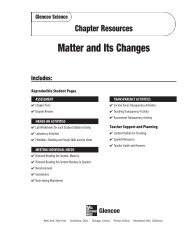Chapter 17: Invertebrate Animals
Chapter 17: Invertebrate Animals
Chapter 17: Invertebrate Animals
Create successful ePaper yourself
Turn your PDF publications into a flip-book with our unique Google optimized e-Paper software.
Runk/Schoenberger from Grant Heilman<br />
Sponges, Cnidarians,<br />
Flatworms, and<br />
Roundworms<br />
Sponges<br />
Can you tell the difference between an animal and a plant<br />
Sounds easy, doesn’t it But for a long time, even scientists didn’t<br />
know how to classify sponges. Originally they thought sponges<br />
were plants because they don’t move to search for food. Sponges,<br />
however, can’t make their own food as most plants do. Sponges<br />
are animals. Adult sponges are sessile (SE sul), meaning they<br />
remain attached to one place. Approximately 15,000 species of<br />
sponges have been identified.<br />
Filter Feeders Most species of sponges live in the ocean, but<br />
some live in freshwater. Sponge bodies, shown in Figure 4, are<br />
made of two layers of cells. All sponges are filter feeders. They<br />
filter food out of the water that flows through their bodies.<br />
Microscopic organisms and oxygen are carried with water into<br />
the central cavity through pores of the sponge. The inner surface<br />
of the central cavity is lined with collar cells. Thin, whiplike<br />
structures, called flagella (flah JEH luh), extend from the collar<br />
cells and keep the water moving through the sponge. Other specialized<br />
cells digest the food, carry nutrients to all parts of the<br />
sponge, and remove wastes.<br />
Body Support and Defense Not many animals eat sponges.<br />
The soft bodies of many sponges are supported by sharp,<br />
glass-like structures called spicules (SPIHK yewlz). Other sponges<br />
have a material called spongin. Spongin is similar to foam rubber<br />
because it makes sponges soft and elastic. Some sponges have both<br />
spicules and spongin to protect their soft bodies.<br />
■ Describe the structures that<br />
make up sponges and cnidarians.<br />
■ Compare how sponges and<br />
cnidarians get food and<br />
reproduce.<br />
■ Differentiate between flatworms<br />
and roundworms.<br />
Studying the body plans in<br />
sponges, cnidarians, flatworms,<br />
and roundworms helps you understand<br />
the complex organ systems<br />
in other organisms.<br />
Review Vocabulary<br />
species: group of organisms that<br />
share similar characteristics and<br />
can reproduce among themselves<br />
New Vocabulary<br />
• cnidarian<br />
polyp<br />
• medusa<br />
Figure 4 Red beard sponges grow<br />
where the tide moves in and out quickly.














